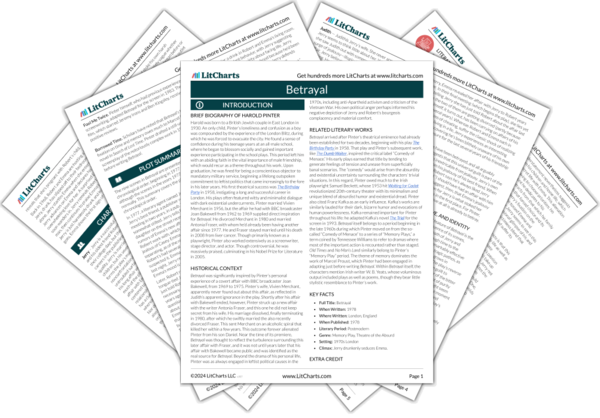Love, Jealousy and Betrayal
The title of Pinter’s play leaves no room for uncertainty about its thematic focus. Moving in reverse-chronological order, the play traces the years-long affair between a married literary agent named Jerry and Emma, his best friend Robert’s wife. Their affair is a betrayal, simple enough: Jerry betrays his wife, and they both betray Robert—Emma as his wife and Jerry as his oldest friend. But the straightforward betrayal in their adultery only begins the…
read analysis of Love, Jealousy and BetrayalTime, Perspective, and Identity
The most striking formal feature of Betrayal is the reverse-chronological sequence of its scenes, beginning in the long aftermath of Jerry and Emma’s affair and moving backward through time to the moment of its inception. This simple but remarkably effective device instills these characters’ story with a tragic pathos, as their ignorance of the sad end awaiting them grows in proportion to the audience’s knowledge of it. The play’s reverse chronology strikes the audience…
read analysis of Time, Perspective, and IdentityLiterature and Integrity
Betrayal takes place against the backdrop of the publishing world of 1970s London. Jerry is a successful literary agent, and his old friend Robert is a successful publisher. Their careers seem to follow naturally from their undergraduate activities in literary magazines, a period that Robert alludes to as one of fervent artistic idealism for them both. Yet the very nature of their work—to make money off (other people’s) books, as distinct from the non-commercial endeavors…
read analysis of Literature and Integrity
Responsibility and Consequences
Children never appear in Betrayal, but their existence at the margins haunts the action of the play, hinting at the unavoidable consequences the central affair has for the other people in Emma and Jerry’s lives. For Jerry, the presence of children defines a home: he tells Emma that their illicit love-pad “could never… actually be a home. You have a home. I have a home. With curtains, etcetera. And Children. Two children in…
read analysis of Responsibility and Consequences






